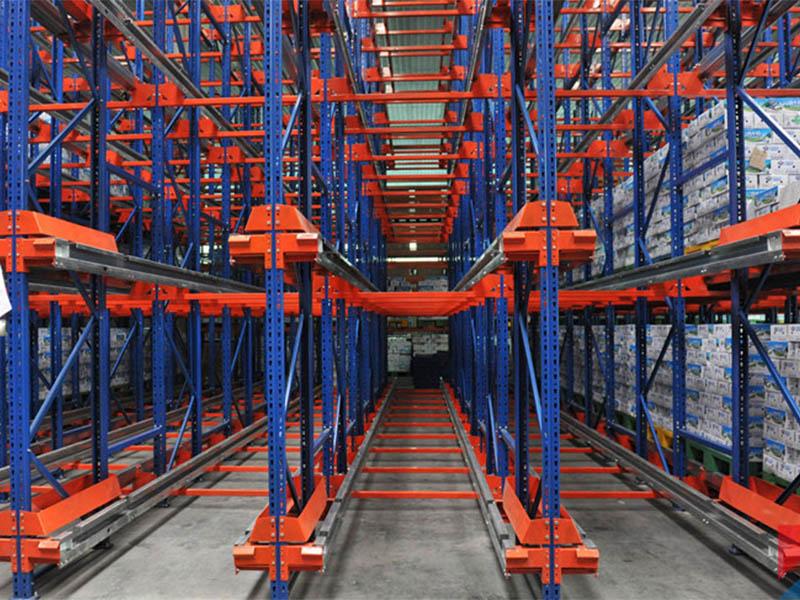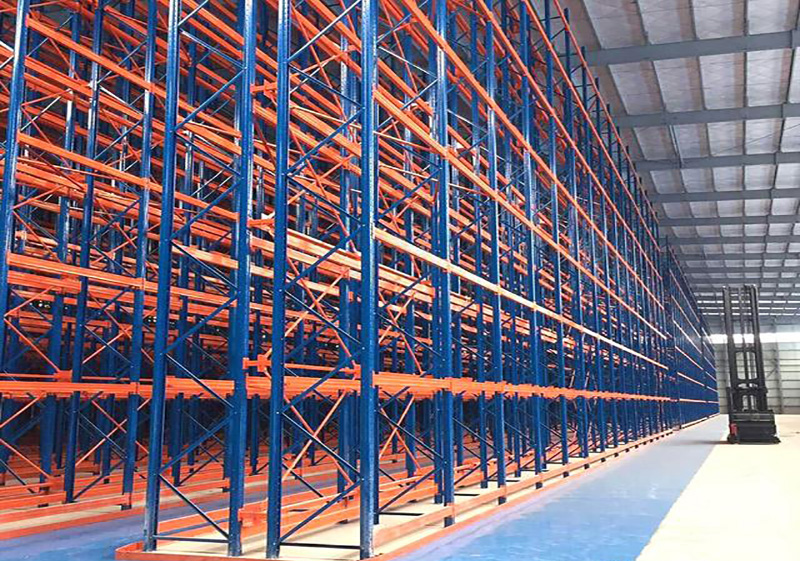In the relentless pursuit of operational efficiency within supply chains, the pallet rack warehouse stands as an indispensable backbone. It's far more than just metal beams and uprights; it's a sophisticated storage strategy designed to optimize cubic space, streamline material flow, enhance inventory accessibility, and ensure safety. For businesses dealing with palletized goods – from manufacturing giants to bustling distribution centers and retailers – understanding and implementing an effective pallet rack warehouse system is paramount to competitiveness. This article delves deep into five critical aspects that define the modern pallet rack warehouse, exploring its components, benefits, design considerations, safety imperatives, and integration with advanced technologies.

1. Understanding the Core: Components and Types of Pallet Rack Systems
At its heart, a pallet rack warehouse is built upon standardized components working in concert:
Upright Frames: Vertical columns, typically roll-formed from steel, forming the primary support structure. They feature punched holes (teardrop or structural bolt-hole) for beam level adjustment.
Beams: Horizontal members that connect to uprights, creating the support levels for pallets. Load capacities vary significantly based on beam profile, length, and steel gauge.
Wire Decking or Pallet Supports: Often used to provide a stable surface for pallets, prevent falling debris, and enhance safety. Can be welded wire mesh or steel sheets.
Row Spacers and Braces: Ensure consistent row spacing and provide lateral stability to the entire structure.
Shims and Baseplates: Used to level the racking on uneven floors and anchor it securely to the concrete slab.
The versatility of the pallet rack warehouse is showcased in its diverse types, each suited to specific operational needs:
Selective Pallet Racking: The most common type. Offers direct access to every pallet location via aisles. Highly flexible for SKU variety but has lower storage density.
Drive-In/Drive-Thru Racking: Designed for high-density storage of homogeneous products (LIFO or FIFO). Forklifts drive directly into the rack structure. Maximizes space but reduces selectivity.
Push-Back Racking: Utilizes inclined carts on nested rails. Pallets are loaded from the front, pushing previous loads backward (LIFO). Offers good density and selectivity balance.
Pallet Flow Racking: Uses gravity rollers or wheels on inclined rails. Pallets are loaded at the higher end and flow to the lower front end (FIFO). Ideal for high-volume, fast-moving, perishable goods.
Cantilever Racking: Features long horizontal arms extending from a central column, perfect for storing long, bulky items like pipes, lumber, or furniture, not typically found in a standard pallet rack warehouse for pallets but often adjacent.
Mobile Pallet Racking (Mobile Aisle): Entire rack sections are mounted on motorized bases that move laterally, eliminating all but one operating aisle. Provides very high density but requires specialized flooring and systems.
Selecting the right type is foundational to the success of any pallet rack warehouse.
2. The Engine of Efficiency: Design, Layout, and Optimization
Designing a pallet rack warehouse is a complex engineering and logistical challenge. It's not simply about filling space; it's about creating a system that aligns perfectly with operational workflows and business objectives. Key considerations include:
Inventory Analysis: Understanding SKU profiles (dimensions, weight, turnover velocity - ABC analysis), pallet sizes, and storage requirements is step one.
Throughput Requirements: How many pallets move in and out per day/week? This dictates aisle width, picking strategies, and dock requirements.
Building Constraints: Clear ceiling height, floor condition and load-bearing capacity, column locations, door positions, and sprinkler systems heavily influence the racking layout and height.
Material Handling Equipment (MHE): The type of forklifts (reach trucks, counterbalanced, turret trucks, order pickers) determines minimum aisle widths and impacts rack configuration (e.g., narrow aisle racking for VNA trucks).
Layout Optimization: Maximizing storage density while maintaining efficient product flow and accessibility. Techniques include:
Slotting: Strategically placing high-turnover items in easily accessible "golden zone" locations.
Aisle Width Optimization: Balancing space savings against MHE maneuverability requirements.
Vertical Space Utilization: Leveraging clear height with taller racking systems where feasible.
Cross-Aisles: Incorporating wider aisles perpendicular to storage aisles to facilitate traffic flow and picking.
Software Utilization: Warehouse Management Systems (WMS) and specialized rack design software are crucial for modeling layouts, optimizing slotting, calculating capacities, and generating bills of materials. A well-designed pallet rack warehouse is a finely tuned engine driving productivity.

3. The Non-Negotiable Foundation: Safety Standards and Best Practices
Safety is paramount in any industrial environment, and a pallet rack warehouse presents specific hazards. Adherence to rigorous standards and proactive safety measures is critical to protect personnel, inventory, and the integrity of the structure itself:
Structural Integrity & Load Ratings: Every component must be rated for the intended load. Exceeding load capacities is a primary cause of catastrophic failure. Uprights and beams must be clearly labeled with their maximum permissible load per level and configuration.
Compliance with Standards: Designs must conform to recognized industry standards like RMI (Rack Manufacturers Institute) ANSI MH16.1 in the US, SEMA in the UK, FEM in Europe, or AS 4084 in Australia. These cover design, testing, installation, inspection, and use.
Professional Installation: Racking must be installed by qualified personnel according to the manufacturer's specifications and engineering drawings. Proper anchoring to the floor slab is essential.
Regular Inspections: Mandatory, documented inspections are required:
Operational (Frequent): Daily/Weekly visual checks by trained warehouse staff for obvious damage.
Expert (Periodic): Formal inspections by a technically competent person (e.g., SARI - Storage Equipment Manufacturers’ Association Registered Installer, or equivalent) at least annually, or more frequently based on risk.
Damage Protocol: Any damage to uprights, beams, braces, or connections must be reported immediately. Damaged components must be unloaded and isolated until inspected and repaired or replaced by qualified personnel. Never attempt makeshift repairs.
Safe Operation: Key practices include:
Ensuring pallets are undamaged and properly positioned on beams.
Never climbing on racking.
Avoiding overloading or uneven loading.
Using proper MHE attachments and operating within rated capacities.
Maintaining clear aisles and visibility.
Installing adequate column guards, rack end protectors, and safety netting where needed.
Proper Documentation: Maintaining up-to-date as-built drawings, load application and configuration drawings (LACRD), inspection records, and repair logs is crucial for liability and safety management. A safe pallet rack warehouse is a productive one.
4. Synergy in Motion: Integration with Material Handling & Automation
A pallet rack warehouse doesn't operate in isolation. Its effectiveness is dramatically amplified when seamlessly integrated with Material Handling Equipment (MHE) and increasingly, automation technologies:
MHE Compatibility: The racking design must align with the chosen forklifts:
Aisle Width: Standard aisles (11-13 ft) for counterbalance trucks. Narrow aisles (8-10 ft) for reach trucks. Very Narrow Aisles (VNA - 5-7 ft) for specialized turret trucks or swing-mast trucks requiring wire guidance or rail guidance.
Lift Height: Racking height must match the maximum lift height of the MHE.
Fork Length & Width: Must be suitable for the beam depth and pallet size to ensure safe placement/retrieval.
Warehouse Management Systems (WMS): The digital brain of the modern pallet rack warehouse. A WMS optimizes:
Putaway: Directing stock to optimal locations based on rules (e.g., velocity, product affinity, FIFO/FEFO).
Picking: Generating efficient pick paths (batch, zone, wave picking) and directing operators.
Inventory Tracking: Providing real-time visibility into stock levels and locations.
Cycle Counting: Facilitating accurate inventory audits.
Automation Integration: Pallet racking forms the storage infrastructure for various automated solutions:
Automated Storage and Retrieval Systems (AS/RS): Cranes operating within the rack structure to automatically store and retrieve pallets. Requires extremely precise racking tolerances.
Automated Guided Vehicles (AGVs) / Autonomous Mobile Robots (AMRs): Transport pallets between racking, docks, and workstations, often interfacing with AS/RS or manual pick stations.
Conveyor Systems: Integrated with racking for sortation and transportation of pallets or cases within the facility.
Pick-to-Light / Put-to-Light Systems: Guide operators to specific locations on the racking, reducing errors and increasing speed. The modern pallet rack warehouse is a dynamic ecosystem where physical structure and digital intelligence converge.
5. The Compelling ROI: Key Benefits and Advantages
Investing in a well-designed and managed pallet rack warehouse delivers substantial and measurable returns:
Maximized Cubic Space Utilization: The primary driver. By storing vertically, racking dramatically increases storage capacity compared to floor stacking, especially in high-clear-height buildings. This defers or eliminates the need for costly facility expansion.
Enhanced Inventory Accessibility & Visibility: Direct access to pallets (especially in selective systems) allows for faster putaway, picking, and cycle counting. Clear organization improves stock visibility.
Improved Operational Efficiency: Optimized layouts, slotting strategies, and integration with WMS/MHE reduce travel time for personnel and equipment, accelerating order fulfillment and throughput.
Increased Inventory Accuracy & Control: Defined locations and WMS integration minimize misplacement and loss, leading to more reliable inventory records.
Enhanced Safety: Properly designed, installed, and maintained racking, combined with safety protocols, significantly reduces the risks of collapses, falling loads, and MHE accidents compared to unsafe stacking practices.
Flexibility & Scalability: Modular systems can be reconfigured, expanded, or even relocated relatively easily to adapt to changing inventory profiles, business growth, or new processes. Systems like mobile racking offer incredible density flexibility.
Product Protection: Proper support prevents pallet and load damage caused by sagging or unstable stacking. Decking further protects goods from below.
Cost-Effectiveness: While the initial investment can be significant, the long-term benefits in space savings, labor efficiency, reduced product damage, and improved inventory control deliver a compelling return on investment (ROI). A well-run pallet rack warehouse is a strategic asset.
The pallet rack warehouse is far more than static storage; it is the dynamic core of efficient logistics operations. From its fundamental components and diverse configurations to the critical imperatives of safety-driven design and maintenance, its impact permeates every aspect of warehouse performance. The integration with sophisticated MHE, WMS, and automation technologies unlocks unprecedented levels of efficiency and accuracy. The tangible benefits – maximizing valuable space, accelerating material flow, enhancing inventory control, protecting assets, and ultimately improving the bottom line – make it an indispensable strategic investment for any business handling palletized goods in volume. Designing, implementing, and maintaining an optimal pallet rack warehouse system, adhering to the highest safety standards, is not just an operational task; it's a fundamental requirement for success in the demanding world of modern supply chain management. As logistics evolve, the adaptable and efficient pallet rack warehouse will continue to be its resilient foundation.







